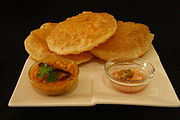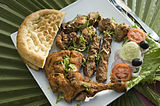Puri (food)
 Puri on a plate | |
| Place of origin | Indian subcontinent |
|---|---|
| Region or state | Indian subcontinent, Southeast Asia, Caribbean |
| Associated cuisine | India, Bangladesh, Pakistan, Nepal, Malaysia, Myanmar, Singapore, Sri Lanka, Mauritius, Trinidad and Tobago, Guyana |
| Serving temperature | Hot or cold |
| Main ingredients | Atta |
| Variations | Bhatoora, Luchi, Sevpuri, Panipuri |
Puri, also poori, is a type of deep-fried bread, made from unleavened whole-wheat flour, originated from the Indian subcontinent.
Puris are most commonly served as breakfast or snacks. It is also served at special or ceremonial functions as part of ceremonial rituals along with other vegetarian food offered in Hindu prayer as prasadam. When hosting guests it is common in some households to serve puri in place of roti, as a small gesture of formality.
Name
The name Puri derives from the Sanskrit word पूरिका (pūrikā), from पुर (pura) "filled".[1] In other South Asian languages it is known as: Urdu: پوری (𝘱𝘰𝘰𝘳𝘪), Dogri: पूरी (pūrī) or पूड़ी (pūṛī), Kumaoni: लगड (lagaḍ), Template:Lang-ta (poori), Template:Lang-te (pūri), Gujarati: પૂરી, Template:Lang-as (puri), Template:Lang-bn (pūri), Template:Lang-hi (pūṛī), Template:Lang-bho (pūṛī), Template:Lang-mr (pūrī), Template:Lang-kn (pūri), Template:Lang-ml (pūrī), Template:Lang-my (pūrī), Template:Lang-ne (puri), Template:Lang-or (puri), Template:Lang-pa (pūṛī), Garhwali: पूरी (pūrī), [2]
Ingredients
Puris are prepared with wheat flour, either atta (whole wheat flour) or sooji (coarse wheat flour). In some recipes, ajwain, cumin seed, spinach, or fenugreek seeds are added to the dough. The dough is either rolled out in a small circle or rolled out and cut out in small circles, then deep fried in ghee or vegetable oil. While deep frying, puris puff up like a round ball because moisture in the dough changes into steam which expands in all directions. They are flipped once in the frying process, and when they are golden-brown in color, they are removed and either served hot or saved for later use (as with the snack food pani puri). Rolled puris may be pricked with a fork before deep frying to make flat puris for chaat like bhel puri. A punctured puri does not puff when cooked because the steam escapes as it cooks. Masala puri adds turmeric, chili powder, coriander and cumin, and hing (asafoetida) to the dough.
Types and variants
Suhari is a variant of puri which is made with wheat flour, ghee and some sugar and also fried in ghee[3] rather than vegetable oils for regular puri.[4] It is often paired with sweet dish Suji Lapsi. Laspi Suhari is a common combo[4] served as a Naivedhya to Hindu Devatas and paired along with Chana Ghugni or Kaumari during Durga Ashtami festival.[5]
Another variant of the puri popular in the eastern part of Indian subcontinent is Luchi (in West Bengal and Odisha) or lusi in Assam, luchui[6] in Bihar[3] and Jharkhand. Luchi is made using refined wheat flour (samidh flour) and is deep fried. It is served with typical side dishes like aloor dum (potato preparation), Chana ghugni, begun bhaja (fried eggplant) and others.
Another variant, largely popular in the Braj culinary tradition of the Northern Indian state of Uttar Pradesh is bedmi puri or bedai.[7] It is prepared using stuffing of Urad dal paste and paired with Mathura's Dubki Aloo jhor.[8]
Another variant of puri is "Khameere/Ambliyaan" bread originating from Dogra cuisine of Jammu region. It is a deep fried leavened bread prepared with naturally fermented sour dough called Ambleya Atta in Dogri language.[9]
Bhathoru or Bhaturu is another bread originating from region of Jammu and Northern Himachal[10] made using same dough as Dogri bread Khameere or Ambliyaan but prepared by roasting or baking in clay oven called bhatthi. The same dish was modified by purabiya vendors of Delhi by preparing it like Luchi bread (replacing whole wheat flour with refined wheat flour and frying it) which came to be known as bhatoora, which is served with Chana Ghugni/Chole Ghugni (spicy chickpeas). See chole bhature.[11]
Thotru is yet another variant originating from Dogra culinary tradition which is prepared using naturally fermented flour dough and stuffed with vegetable fillings and rolled in toppings of nuts like almonds, sesame seeds, poppy seeds etc.[12] They can be fried or baked.
In the Indian state of Odisha a large-sized puri is made during Bali Yatra which is called thunka puri (Template:Lang-or).[13][14][15][16][17]
The puris used for panipuri are smaller, and are usually made crisper by the addition of rava/sooji (semolina) to the dough.
Sev puri is an Indian snack offered by street vendors who serve chaat.
Street vendors in Mumbai serve bhel in a throw-away folded leaf with a flat puri to scoop it.
Fast food chains in the Middle East use puri for fried chicken wraps.
Gallery
-
Aloo puri, a typical morning snack in Varanasi, India
-
Puri frying in Pakistan
-
Puri is traditionally deep fried
-
Dal puri, a traditional Bengali version
-
Mini-puris are part of a panipuri snack. It is crunchier in texture
-
Daal puri, Bangladesh
-
Thin bread is fried in oil and eaten with a salty curry of chickpeas, potatoes and sweet pudding.
-
Puri, made of wheat flour, which is used in panipuri.
-
Puri, made of rawa, which is used in panipuri.
See also
References
- ^ Tokuji Watanambe (1986). Traditional Foods: Some Products and Technologies. Central Food Technological Research Institute. p. 56.
- ^ Tokuji Watanambe (1986). Traditional Foods: Some Products and Technologies. Central Food Technological Research Institute. p. 56.
- ^ a b Grierson, Sir George Abraham (1885). Bihār Peasant Life: Being a Discursive Catalogue of the Surroundings of the People of that Province, with Many Illustrations from Photographs Taken by the Author. Bengal secretariat Press.
luchui, and (Tirhut) sohāri or suhari, - thin cakes boiled in clarified butter
- ^ a b "Lapsi and Suhari - CaribMagPlus". 5 November 2021. Retrieved 24 August 2024.
The Suhari is made with flour, water and sugar.
- ^ Dasa, Syamasundara (1965–1975). "Hindi sabdasagara". dsal.uchicago.edu. Retrieved 24 August 2024.
सादी पूरी नामक पकवान जिसमें पीठी आदि नहीं भरी रहती ।
- ^ Folk Culture: Folk culture & literature. Institute of Oriental and Orissan Studies. 1983.
Luchui (flour - cakes cooked in ghee)
- ^ "Bedai Puri, The Origin Of Uttar Pradesh's Special Breakfast Dish". Times Now. 19 January 2024. Retrieved 24 August 2024.
- ^ "UK Chef Makes Mathura Ke Dubki Wale Aloo, Fans Want Him To Start Restaurant In India". News18. 8 May 2023. Retrieved 24 August 2024.
scrumptious dish, which finds its roots in Mathura and is called Mathura Ke Dubki Wale Aloo.
- ^ blessmyfoodbypayal (30 April 2020). "Jammu special Khamira recipe | jammu wale khamire | bless my food". Bless My Food By Payal. Retrieved 24 August 2024. [Khamira is a soft leavened fried bread made with flour and khamir (sour dough/homemade yeast), an old traditional recipe from Jammu region of UT of J&K]
- ^ "Move Over Bhatura, We Have Himachali Bhaturu! Recipe Inside". www.slurrp.com. Retrieved 24 August 2024.
For the baked or roasted version, one needs to place the raw bhaturu on a heated tawa.
- ^ Ramineni, Shubhra (28 February 2012). Entice With Spice: Easy Indian Recipes for Busy People. Tuttle. ISBN 9781462905270.
- ^ Dhar, Somnath (1986). Jammu and Kashmir Folklore. Marwah Publications. ISBN 978-0-8364-1809-5.
Thothru, well - kneaded fermented balls cooked in boiling ghee with almonds
- ^ "Overview of Cuttack". Archived from the original on 13 August 2011. Retrieved 28 November 2011.
- ^ Fanfare & spectacle mark the opening of Bali Yatra Archived 3 April 2015 at the Wayback Machine, 10 November 2011
- ^ Orissa CM Naveen Patnaik inaugurates historic Baliyatra festival in Cuttack Archived 7 March 2016 at the Wayback Machine, 22 November 2010
- ^ Bali Yatra Fever grips Cuttack, 12 November 2011 Archived 13 November 2011 at the Wayback Machine
- ^ Binita Jaiswal, Fanfare & spectacle mark the opening of Bali Yatra, 10 November 2011
External links
- Indian fast food
- Indian breads
- Punjabi cuisine
- Sindhi cuisine
- Muhajir cuisine
- Pakistani fast food
- Pakistani breads
- Uttar Pradeshi cuisine
- Flatbreads
- Unleavened breads
- Kerala cuisine
- Tamil cuisine
- Odia cuisine
- Bengali cuisine
- Nepalese cuisine
- Sri Lankan cuisine
- Telangana cuisine
- Andhra cuisine
- Karnataka cuisine
- Fijian cuisine
- Malaysian breads
- Gujarati cuisine
- Deep fried foods
- Bangladeshi cuisine
- Burmese cuisine
- Indo-Caribbean cuisine
- Guyanese cuisine













